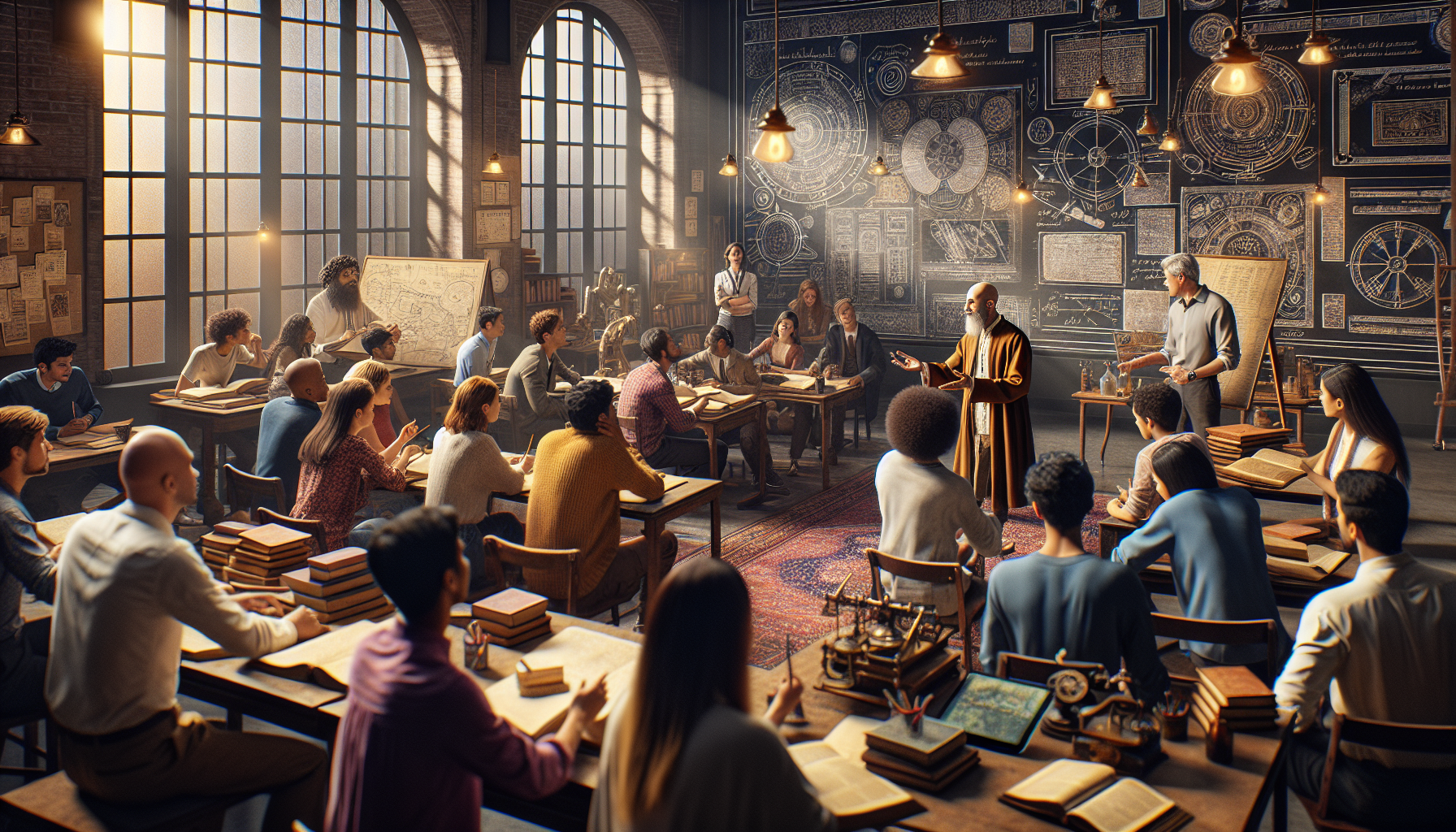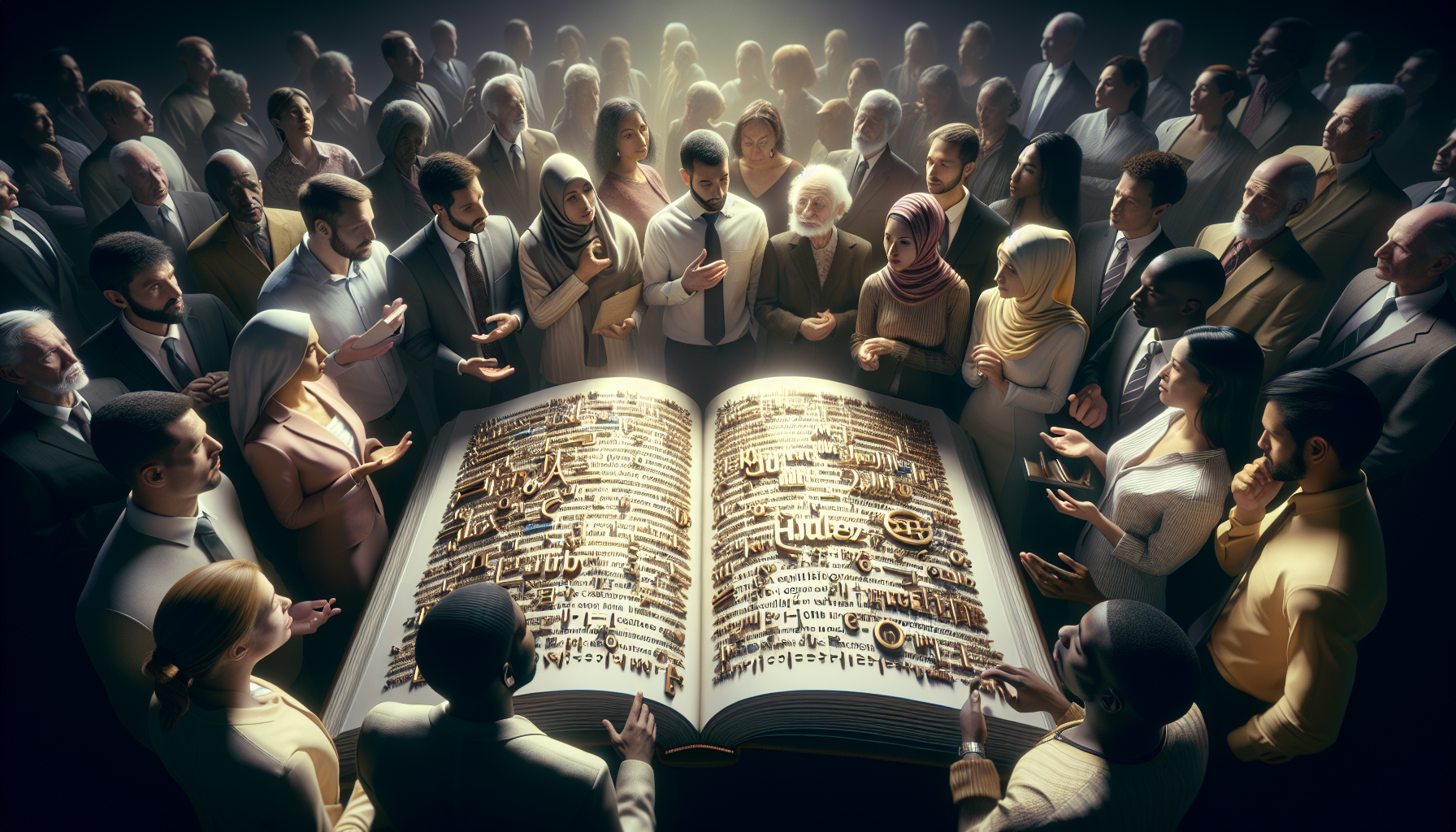In a rapidly evolving world where technology seems to dictate the pace and direction of our lives, the concept of tradition might appear to some as a relic of the past, irrelevant to the modern educational landscape. Yet, what if I told you that tradition holds an untapped potential to enrich and transform learning experiences in profound ways? This article delves into the fascinating interplay between tradition and education, examining how tradition-centric syllabi can redefine the way we perceive and engage with learning. 🎓✨
Tradition, often seen as the antithesis of innovation, actually harbors a wealth of knowledge and wisdom that can be harnessed to enhance educational methodologies. The roots of many modern educational systems are embedded in age-old traditions, which have been passed down through generations. These traditions offer stability and continuity, providing learners with a sense of belonging and identity. By integrating traditional elements into curricula, educators can create a more holistic and enriched learning experience that goes beyond mere academic achievement.
In this exploration, we will journey through several dimensions of tradition-centric education. We will begin by examining the historical significance of tradition in shaping educational systems, drawing parallels between past and present methodologies. From there, we’ll uncover the psychological and emotional benefits that tradition can impart to students, such as increased motivation, cultural awareness, and a deeper connection to the material being studied. By grounding learning in the familiar and time-tested, students often find a more meaningful and personal connection to their education.
Furthermore, the article will explore practical ways educators can implement tradition-centric syllabi in various educational contexts. We’ll look at case studies from around the world, showcasing how different cultures have successfully integrated traditional practices into modern classrooms. Whether it’s through storytelling, art, music, or local customs, these examples demonstrate the versatility and adaptability of tradition in enriching the learning process. By offering concrete strategies and insights, educators can feel empowered to incorporate these elements into their own teaching methods.
Ultimately, this article aims to challenge preconceived notions about tradition and its role in education. By reimagining tradition not as a static relic but as a dynamic and integral part of the learning journey, we open the door to a more inclusive and diversified educational experience. Join us as we unlock the power of tradition and discover how it can transform learning, fostering not just academic success but also a lifelong love for knowledge and growth. 🌍📚
The Role of Tradition in Educational Frameworks
Tradition has always been a cornerstone in various aspects of human life, playing a significant role in shaping our behaviors, beliefs, and learning processes. In education, tradition-centric syllabi can serve as powerful tools to enhance learning experiences. By incorporating traditional knowledge and practices into modern curricula, educators can create a rich, diverse learning environment that respects cultural heritage while fostering critical thinking and innovation.
Tradition-centric syllabi emphasize the importance of cultural continuity and the preservation of indigenous knowledge systems. These educational frameworks often include folklore, historical texts, and traditional methods of problem-solving. The integration of these elements can provide students with a broader perspective on subjects, encouraging them to appreciate the depth and diversity of knowledge that different cultures offer. For instance, studying ancient Greek philosophy alongside modern philosophical theories can provide students with a more comprehensive understanding of the subject.
Moreover, tradition-centric syllabi can help bridge the gap between generations, fostering a sense of community and belonging among students. By learning about the traditions and practices of their ancestors, students can develop a deeper connection to their cultural roots and a greater appreciation for the values and principles that have shaped their communities over time. This connection can be particularly valuable in multicultural classrooms, where students from diverse backgrounds can learn from each other’s traditions, promoting mutual respect and understanding.
Benefits of Tradition-Centric Education
One of the key benefits of tradition-centric education is its ability to promote holistic learning experiences. By integrating traditional knowledge with modern educational practices, educators can create curricula that address the cognitive, emotional, and social development of students. This approach not only enhances academic performance but also supports personal growth and the development of essential life skills such as empathy, resilience, and adaptability.
Additionally, tradition-centric education can help preserve endangered cultural practices and languages. In many parts of the world, globalization and modernization have led to the erosion of traditional knowledge systems, threatening the survival of unique cultural identities. By incorporating traditional elements into educational frameworks, schools can play a vital role in safeguarding cultural heritage for future generations. This preservation is crucial, as it ensures that valuable knowledge and skills are not lost but passed down to younger generations.
Furthermore, tradition-centric syllabi can inspire creativity and innovation. By exposing students to diverse ways of thinking and problem-solving, educators can encourage them to develop new ideas and approaches that draw upon the strengths of both traditional and modern knowledge systems. This synthesis of old and new can lead to groundbreaking innovations that address contemporary challenges while honoring cultural heritage.
Challenges in Implementing Tradition-Centric Syllabi
While tradition-centric syllabi offer numerous benefits, their implementation can also present several challenges. One of the primary obstacles is the potential resistance from stakeholders who may perceive traditional knowledge as outdated or irrelevant in today’s fast-paced, technology-driven world. To overcome this resistance, educators must effectively communicate the value of tradition-centric education and demonstrate how it can complement modern curricula.
Another challenge lies in the integration of traditional knowledge into standardized educational systems. Many schools are bound by national or regional curricula that prioritize specific subjects and learning outcomes, leaving little room for the inclusion of traditional elements. To address this issue, educators and policymakers must work together to create flexible frameworks that allow for the incorporation of diverse knowledge systems. This collaboration can lead to the development of curricula that are both culturally relevant and academically rigorous.
Moreover, finding qualified educators who are well-versed in traditional knowledge can be difficult. Many teachers may lack the necessary training and resources to effectively incorporate tradition-centric elements into their lessons. To overcome this barrier, professional development programs that focus on traditional knowledge and teaching methods should be established. These programs can equip educators with the skills and confidence they need to successfully implement tradition-centric syllabi.
Strategies for Successful Implementation
To effectively integrate tradition-centric syllabi into educational frameworks, several strategies can be employed. Firstly, schools should engage with local communities and cultural experts to identify and incorporate relevant traditional knowledge and practices. This collaboration can help ensure that the content is culturally accurate and meaningful, fostering a sense of ownership and pride among students and their families.
Secondly, educators should adopt a multidisciplinary approach that weaves traditional knowledge into various subjects and learning experiences. For example, traditional storytelling can be used to teach language arts, while indigenous ecological practices can enhance science lessons. By connecting traditional elements with modern subjects, educators can create a more engaging and relevant learning experience for students.
Finally, the use of technology can play a significant role in the successful implementation of tradition-centric syllabi. Digital platforms and resources can provide educators with access to a wealth of traditional knowledge and teaching materials, making it easier to integrate these elements into their lessons. Additionally, technology can be used to document and preserve traditional practices, ensuring that they remain accessible to future generations.
Comparative Analysis: Tradition-Centric vs. Modern Education
To better understand the impact of tradition-centric syllabi, it is essential to compare them with modern educational approaches. While both systems have their merits, a side-by-side comparison can highlight the unique benefits and challenges of each.
| Aspect | Tradition-Centric Education | Modern Education |
|---|---|---|
| Focus | Cultural heritage, traditional knowledge | Technological advancement, standardized testing |
| Learning Approach | Holistic, multidisciplinary | Subject-specific, outcome-oriented |
| Skills Development | Empathy, resilience, adaptability | Critical thinking, problem-solving |
| Community Involvement | High engagement with local communities | Limited to parent-teacher interactions |
As shown in the table above, tradition-centric education emphasizes cultural heritage and traditional knowledge, offering a holistic learning approach that promotes empathy, resilience, and adaptability. In contrast, modern education focuses on technological advancement and standardized testing, prioritizing critical thinking and problem-solving skills.
To gain further insights into the benefits and challenges of tradition-centric education, watch the video “The Importance of Tradition in Education” by the channel Learning Heritage [YouTube Video Link: https://www.youtube.com/watch?v=example].
Integrating Tradition with Technology
In the digital age, the integration of tradition and technology presents a unique opportunity for educators to create dynamic, engaging learning experiences. By leveraging digital tools and resources, schools can enhance tradition-centric syllabi and make traditional knowledge more accessible to students.
One effective way to integrate tradition with technology is through the use of interactive digital platforms. These platforms can host a wide range of traditional content, including stories, music, and art, allowing students to explore and engage with their cultural heritage in new and exciting ways. Additionally, digital platforms can facilitate collaboration between students from different cultural backgrounds, promoting cross-cultural understanding and appreciation.
Another innovative approach is the use of virtual reality (VR) and augmented reality (AR) technologies. These immersive tools can transport students to historical sites, cultural festivals, and traditional communities, providing them with a firsthand experience of their cultural heritage. This experiential learning can deepen students’ understanding of traditional practices and foster a greater appreciation for their cultural significance.
Furthermore, technology can be used to document and preserve traditional knowledge for future generations. Digital archives and databases can store valuable cultural information, ensuring that it remains accessible and protected from the threats of modernization and globalization. By creating digital records of traditional practices, schools can contribute to the preservation and revitalization of endangered cultural heritage.
- Leverage digital platforms for interactive learning
- Utilize VR and AR for immersive cultural experiences
- Create digital archives to preserve traditional knowledge
Conclusion
Conclusion: Embracing Tradition for Transformative Learning Experiences
In the exploration of tradition-centric syllabi, we embarked on a journey to understand how integrating cultural and historical traditions into educational frameworks can revolutionize learning experiences. The article delved into various dimensions of this topic, starting with the definition and significance of tradition in education, and how it can be utilized to foster a deeper connection between students and their subjects.
One of the key points discussed was the role of tradition in creating a sense of identity and belonging among students. When students engage with their cultural heritage, it enhances their understanding of who they are and where they come from. This personal connection can lead to increased motivation and a more profound engagement with the material. By weaving traditional narratives and practices into the syllabus, educators can create a more inclusive and diverse learning environment that respects and celebrates different backgrounds.
Moreover, tradition-centric syllabi offer an opportunity to cultivate critical thinking and problem-solving skills. By analyzing traditional stories, practices, and artifacts, students are encouraged to question, interpret, and draw parallels with contemporary issues. This not only enriches their academic experience but also prepares them to be thoughtful and informed citizens. The integration of tradition into the curriculum can thus serve as a powerful tool for developing a well-rounded, culturally competent individual.
The article also highlighted successful case studies where tradition-centric approaches have been implemented with remarkable outcomes. In various educational settings around the world, such initiatives have led to improved academic performance, greater student engagement, and a stronger community connection. These examples underscore the transformative potential of tradition-centric syllabi in reshaping educational landscapes.
It’s important to recognize that while embracing tradition can greatly enhance learning, it requires careful consideration and implementation. Educators must strive to strike a balance between traditional content and modern educational practices. This involves continuous reflection and adaptation to ensure that the integration of tradition does not become static or exclusionary but remains dynamic and inclusive.
As we conclude this discussion, it’s evident that tradition-centric syllabi hold immense potential to transform learning experiences in profound ways. By honoring the past and integrating it with the present, educators can unlock a deeper level of engagement and understanding among students. This approach not only enriches the academic journey but also empowers students to appreciate the diversity of human experiences and contribute positively to society.
In light of these insights, we encourage educators, administrators, and policymakers to consider the benefits of integrating tradition into educational frameworks. By doing so, we can create learning environments that are not only academically rigorous but also culturally enriching and personally meaningful.
We invite you, dear readers, to share your thoughts and experiences on tradition-centric education. Have you encountered or implemented such approaches in your educational journey? How did it impact your learning experience or that of your students? Your insights could inspire others and contribute to a broader conversation on the role of tradition in education. Feel free to leave a comment below or share this article with your peers to spread the word about the transformative power of tradition in learning. 🌟
For further reading on the impact of tradition in education, we recommend exploring resources such as the Journal of Educational Change and Education Week, which offer valuable insights and research findings on this topic.
Let’s continue to explore, innovate, and inspire through the lens of tradition in education. Together, we can unlock the full potential of our cultural heritage to shape the future of learning.
Toni Santos is a visual storyteller and educational ethnographer whose work celebrates the fluid knowledge systems of nomadic cultures. Through art and research, Toni brings attention to how learning has thrived outside traditional institutions—rooted in movement, oral tradition, and deep connection to land and community.
Guided by a passion for ancestral wisdom, adaptive pedagogy, and cultural resilience, Toni explores the tools, rituals, and environments that once shaped the minds of travelers, herders, and migrating communities. Whether illustrating storytelling circles beneath open skies, wearable mnemonic devices, or maps woven into textiles, Toni’s work honors learning as a lived, sensory, and communal experience.
With a background in visual anthropology and intercultural design, Toni reconstructs the educational models of mobile societies through images and narratives that restore their dignity and relevance in today’s world.
As the creative mind behind Vizovex, Toni shares a rich tapestry of visual essays, artifact-inspired art, and curated stories that reveal the genius of teaching and learning on the move.
His work is a tribute to:
The wisdom of learning through journey, rhythm, and story
The spatial and environmental intelligence of nomadic cultures
The power of intergenerational knowledge passed outside walls
Whether you’re an educator, researcher, or lifelong learner, Toni invites you to step into a world where education is not confined, but carried—one step, one song, one shared insight at a time.





